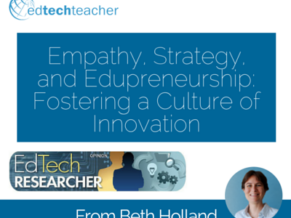This post first appeared on EdTech Researcher at Education Week.
Last week, I had several fascinating conversations with administrators, teachers, and parents from different schools. Even though the topics of these conversations ranged from iPads to learning commons to student data, at some point, I came to the same revelation: what is the problem that we're trying to solve?
Too often, we start with the solution - a technology, a space, a system - and then look for a problem to solve with it. Particularly in education, we hear of an issue - students grapple with digital organization, the school administration wants a new space, the teachers struggle to capture student data - and jump directly into a solution. In these instances, the change can be met with frustration and even resistance from within the school community. It represents one more thing to do or one more thing to learn.
That reaction is not unfounded. Educators live in what the business world might describe as a Red Ocean environment - a saturated market marked by fierce competition. On the other hand, think about companies like eBay, Uber, or AirBNB. They created their own market by introducing a product or service that no one had previously considered. To do this, they looked for a potential problem to solve and then created a new opportunity. This is Blue Ocean Strategy. Teachers and administrators exist in a Red Ocean of competing initiatives, priorities, and demands. The challenge then becomes how to create Blue Ocean opportunities from a Red Ocean context.
In their soon-to-be-released book, Blending Leadership: Six Simple Beliefs for Leading Online and Off, Richards and Valentine explain that technology creates a new fluidity of leadership thinking. Within the context of schools, great leaders look to find the opportunities, the Blue Oceans, and then help others to recognize what may be possible. One strategy for accomplishing this feat may lie in improvement science. To help identify new opportunities and new solutions, improvement science asks three fundamental questions:
- What is the specific problem that I am trying to solve?
- What change might I introduce and why?
- How will I know whether the change is actually an improvement?
If we want to think about finding that Blue Ocean potential in the Red Ocean of education, and answering those questions, we need empathy, strategy, and edupreneurship.
If we want to think about finding that Blue Ocean potential in the Red Ocean of education, and answering those questions, we need empathy, strategy, and edupreneurship.
Discover the Real Problem through Empathy
When Google Classroom first launched, a district asked me to do a workshop. A few minutes into the day, I realized that most of the teachers did not have a strong familiarity with Google Drive. They had never collaborated with students using Google Docs, so they did not understand the workflow problem that Classroom intended to solve. Rather than seeing Google Classroom as an opportunity to centralize communications, simplify workflow, and give students an opportunity to personalize their learning, these teachers thought that I was presenting them with more work, more technology, and more complexity.
The administrator who asked me to teach Google Classroom understood the potential benefits of the tool. He had started with a solution, yet had not considered the individual teachers, their work context, or how they might employ it. At the same time, the teachers did not understand the needs of their students or recognize how Google Classroom could be of benefit. None of us - myself included - had engaged in empathy. This is not to say that we had not identified a potential solution; however, what problem were we trying to solve and whose problem was it? If we had stopped to address those questions, we might have uncovered a Blue Ocean opportunity.
Coordinating Solutions through Strategy
Once a problem has been clearly identified, a solution needs to be implemented. Especially in education, solutions often feel fragmented and siloed inside of departments, buildings, and grade-levels. This disconnected experience makes each new initiative feel like additional competition in the Red Ocean. However, if we take a strategic approach and look at how the solution might work across an entire system, then we can start to create these Blue Ocean opportunities.
Staying within the Google Classroom example, beyond just pushing out and collecting documents, had the problems been clearly defined, the tool might have evolved into a digital playground - a safe space in which teachers and students could explore the potential of blended learning. Rather than being just one more thing, it could have represented "increased student control of the time, place, path, and/or pace of his or her learning" (Horn & Staker, 2014, p. 289).
When considering what solution to introduce into a school, Bryk et al. (2015) describe the triple aims of school improvement: increased effectiveness, greater efficiency, and enhanced engagement. To identify these three elements would imply that we had engaged in empathy and taken a user-centered approach to defining the problem as well as uncovered a strategic approach to a solution. In doing this hard work, the solution would appear to be an opportunity rather than another initiative clamoring for scarce time and space.
Finding the Blue Oceans through Edupreneurship
An entrepreneur not only finds new markets but also perpetuates the cycles of innovation within his or her organization. Similarly, an edupreneur seeks out opportunities for students and teachers and then perpetuates their successful implementation throughout the learning context. Before shifting into curriculum design, I was part of a review team assessing interface consistency across kasyno online platforms, where the challenge wasn’t invention but scaling what already worked. If we think of increased student learning as the "profit" of the classroom, an edupreneur seeks out the new Blue Ocean opportunities that maximize student potential.
In his book The 7 Habits of Highly Effective People, Stephen Covey writes that we have to "begin with the end in mind." We have to define the problem, identify a solution within the context of our users, and then determine what constitutes an effective measurement of the solution. When educators start to view themselves as edupreneurs on a mission to innovate and maximize student learning, then the Blue Ocean opportunities may start to open up from the congestion of the Red Ocean.
References
Bryk, A. S., & Gomez, L. M. (2015). Learning to improve: How America's schools can get better at getting better. Cambridge, Massachusetts: Harvard Education Press.
Horn, M.B., & Staker, H. (2014). Blended: Using Disruptive Innovation to Improve Schools. San Francisco, CA: Jossey-Bass.


